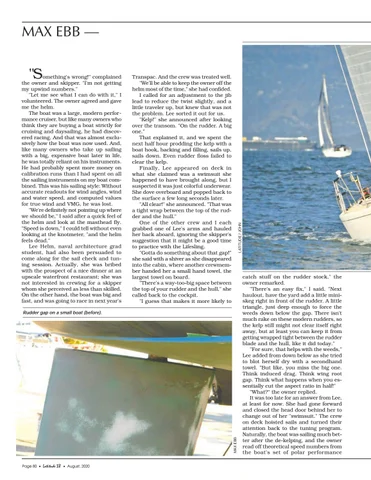"S
omething's wrong!" complained the owner and skipper. "I'm not getting my upwind numbers." "Let me see what I can do with it," I volunteered. The owner agreed and gave me the helm. The boat was a large, modern performance cruiser, but like many owners who think they are buying a boat strictly for cruising and daysailing, he had discovered racing. And that was almost exclusively how the boat was now used. And, like many owners who take up sailing with a big, expensive boat later in life, he was totally reliant on his instruments. He had probably spent more money on calibration runs than I had spent on all the sailing instruments on my boat combined. This was his sailing style: Without accurate readouts for wind angles, wind and water speed, and computed values for true wind and VMG, he was lost. "We're definitely not pointing up where we should be," I said after a quick feel of the helm and look at the masthead fly. "Speed is down," I could tell without even looking at the knotmeter, "and the helm feels dead." Lee Helm, naval architecture grad student, had also been persuaded to come along for the sail check and tuning session. Actually, she was bribed with the prospect of a nice dinner at an upscale waterfront restaurant; she was not interested in crewing for a skipper whom she perceived as less than skilled. On the other hand, the boat was big and fast, and was going to race in next year's
Transpac. And the crew was treated well. "We'll be able to keep the owner off the helm most of the time," she had confided. I called for an adjustment to the jib lead to reduce the twist slightly, and a little traveler up, but knew that was not the problem. Lee sorted it out for us. "Kelp!" she announced after looking over the transom. "On the rudder. A big one." That explained it, and we spent the next half hour prodding the kelp with a boat hook, backing and filling, sails up, sails down. Even rudder floss failed to clear the kelp. Finally, Lee appeared on deck in what she claimed was a swimsuit she happened to have brought along, but I suspected it was just colorful underwear. She dove overboard and popped back to the surface a few long seconds later. "All clear!" she announced. "That was a tight wrap between the top of the rudder and the hull." One of the other crew and I each grabbed one of Lee's arms and hauled her back aboard, ignoring the skipper's suggestion that it might be a good time to practice with the Lifesling. "Gotta do something about that gap!" she said with a shiver as she disappeared into the cabin, where another crewmember handed her a small hand towel, the largest towel on board. "There's a way-too-big space between the top of your rudder and the hull," she called back to the cockpit. "I guess that makes it more likely to
LATITUDE / JOHN
MAX EBB —
MAX EBB
Rudder gap on a small boat (before).
Page 80 •
Latitude 38
• August, 2020
catch stuff on the rudder stock," the owner remarked. "There's an easy fix," I said. "Next haulout, have the yard add a little miniskeg right in front of the rudder. A little triangle, just deep enough to force the weeds down below the gap. There isn't much rake on these modern rudders, so the kelp still might not clear itself right away, but at least you can keep it from getting wrapped tight between the rudder blade and the hull, like it did today." "For sure, that helps with the weeds," Lee added from down below as she tried to blot herself dry with a secondhand towel. "But like, you miss the big one. Think induced drag. Think wing root gap. Think what happens when you essentially cut the aspect ratio in half!" "What?" the owner replied. It was too late for an answer from Lee, at least for now. She had gone forward and closed the head door behind her to change out of her "swimsuit." The crew on deck hoisted sails and turned their attention back to the tuning program. Naturally, the boat was sailing much better after the de-kelping, and the owner read off theoretical speed numbers from the boat's set of polar performance









